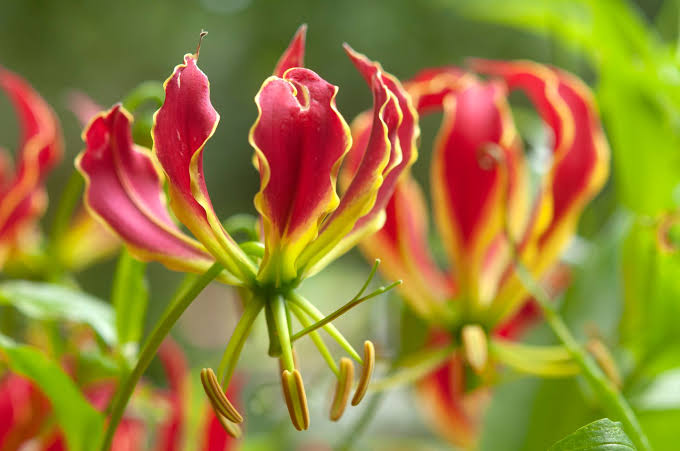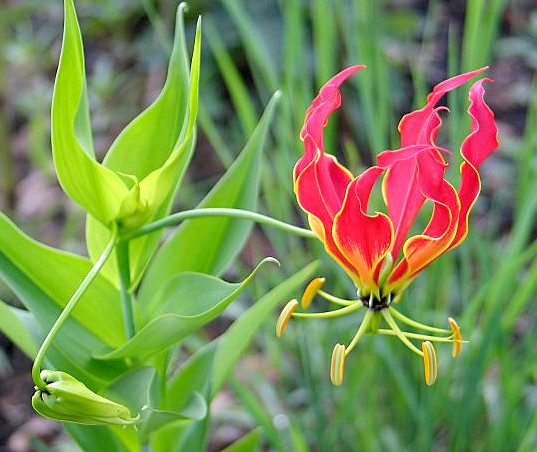The Gloriosa plant, scientifically known as Gloriosa superba, is a fascinating botanical specimen that has been treasured for centuries for its various medicinal properties. This article delves into the rich history and the diverse range of health benefits associated with this remarkable plant.
The history of the Gloriosa plant’s medicinal use is deeply rooted in traditional medicine systems across different parts of the world. Its vibrant history highlights its significance as a source of healing and its cultural importance. Let’s explore the historical journey of the Gloriosa plant in traditional medicine.
The Botanical Description of Gloriosa Plant
1. Life: The Gloriosa plant is a perennial, herbaceous climber that belongs to the Colchicaceae family. It is known for its striking appearance, characterized by bright, flame-like flowers and long, tendril-like leaves.
2. Leaves: The leaves of the Gloriosa plant are lanceolate and arranged alternately along the stem. They are usually around 4 to 6 inches in length and have a glossy appearance.
3. Flowers: One of the most distinctive features of the Gloriosa plant is its stunning flowers. They are typically red or orange with yellow tips, resembling a flame or a claw-like structure. These vibrant flowers make the plant easily recognizable.
4. Roots: The Gloriosa plant has tuberous roots, which are storage organs that allow the plant to survive adverse conditions. These roots are essential for its perennial growth cycle.
5. Climbing Mechanism: Gloriosa is a climbing plant, and it employs tendrils at the tips of its leaves to support its vertical growth. These tendrils help the plant cling to nearby structures or vegetation for support.
6. Habitat: The Gloriosa plant is native to tropical and subtropical regions of Africa and Asia. It thrives in well-drained, sandy soils and requires ample sunlight for optimal growth.
7. Toxicity: It’s crucial to note that the Gloriosa plant contains toxic compounds, particularly colchicine, which can be harmful if ingested. Caution should be exercised when handling this plant.
8. Cultural Significance: Beyond its botanical attributes, the Gloriosa plant holds cultural significance in various regions. It is often used in religious ceremonies and festivals, symbolizing different aspects of life and spirituality.
The Geographic Distribution of Gloriosa Plant
1. Native Regions: The Gloriosa plant, also known as the Glory Lily, is native to various regions of tropical and subtropical Africa and Asia. It thrives in climates characterized by warmth and adequate rainfall.
2. African Range: In Africa, Gloriosa can be found in countries such as Kenya, Tanzania, Uganda, and South Africa. It is particularly abundant in the eastern and southern parts of the continent.
3. Asian Range: Across Asia, the plant’s distribution includes countries like India, Sri Lanka, Myanmar, and Malaysia. It typically grows in regions with a monsoonal climate.
4. Habitat Preferences: Gloriosa plants prefer well-drained soils, including sandy and loamy soils. They are often found in grasslands, forest margins, and along riverbanks.
5. Altitude Range: This plant species can be found at a wide range of altitudes, from sea level to higher elevations, depending on the local climate conditions.
6. Cultivation Beyond Native Range: Due to its striking appearance and potential medicinal uses, Gloriosa has also been cultivated in other parts of the world, where it may not be native but can still thrive under controlled conditions.
The Chemical Composition of Gloriosa Plant
1. Alkaloids: The Gloriosa plant contains alkaloids, including colchicine and gloriosine, which are responsible for its toxicity but also have medicinal applications.
2. Glycosides: It contains glycosides like colchicoside, which have been studied for their potential therapeutic effects.
3. Flavonoids: Gloriosa contains flavonoids, such as quercetin and kaempferol, known for their antioxidant properties.
4. Phenolic Compounds: Phenolic compounds found in the plant contribute to its medicinal properties and may have anti-inflammatory effects.
5. Terpenoids: Some terpenoids are present in Gloriosa and may play a role in its biological activities.
6. Proteins and Enzymes: The plant also contains various proteins and enzymes that have been investigated for their potential benefits.
7. Triterpenoids: Certain triterpenoids have been identified in Gloriosa, and these compounds are of interest for their potential pharmacological activities.
The Cultivation and Growth of Gloriosa Plant
1. Soil and Sunlight: Gloriosa plants thrive in well-drained soils with good sunlight exposure. Sandy or loamy soils are preferred for cultivation.
2. Planting: The tuberous roots of Gloriosa are typically planted in the spring. They should be buried about 2 to 3 inches deep.
3. Watering: Adequate moisture is crucial during the growing season, but the plant should not be waterlogged.
4. Trellising: As a climbing plant, Gloriosa requires support for its vines to grow vertically. Trellises or fences are commonly used for this purpose.
5. Pruning: Pruning can help manage the growth and shape of the plant, especially if it becomes too dense.
The Harvesting and Processing of Gloriosa Plant
1. Harvesting: Gloriosa plant parts, especially the tubers, are typically harvested after the plant has gone dormant, usually in late autumn or early winter.
2. Drying: After harvesting, the tubers are carefully cleaned and dried. This drying process is essential to preserve their medicinal properties.
3. Toxic Compound Removal: Special care must be taken to remove toxic compounds like colchicine during processing to ensure the safety of any products derived from the plant.
4. Medicinal Product Production: The processed plant material is often used to create various medicinal products, including tinctures, powders, and extracts.
5. Traditional Practices: In some cultures, traditional methods of preparation and processing are still used to harness the plant’s therapeutic potential.
6. Quality Control: Due to the toxicity of Gloriosa, quality control measures are crucial in processing to ensure the safety and efficacy of medicinal products.
7. Research and Development: Ongoing research seeks to improve the processing techniques to maximize the benefits of Gloriosa while minimizing its risks.
8. Legal Regulations: In many regions, the harvesting and processing of Gloriosa are subject to legal regulations to prevent misuse and ensure safety.
Read Also: 16 Medicinal Health Benefits of Chervil (Anthriscus cerefolium)
The Medicinal Health Benefits Of Gloriosa Plant (Glory Lily)

Gloriosa plant, commonly known as the Glory Lily, possesses a wide array of medicinal health benefits, making it a subject of interest in traditional and modern medicine. Here are 15 notable health benefits associated with this remarkable plant:
1. Anti-Inflammatory Properties: Gloriosa exhibits anti-inflammatory effects, potentially aiding in the management of inflammatory conditions.
2. Pain Relief: It has analgesic properties and may be used to alleviate pain, including joint and muscle pain.
3. Antipyretic Effects: Gloriosa may help reduce fever, making it valuable in treating febrile illnesses.
4. Antioxidant Activity: The plant contains antioxidants that can combat oxidative stress and protect cells from damage.
5. Anticancer Potential: Research suggests that Gloriosa may have anticancer properties, with compounds like colchicine showing promise in cancer treatment.
6. Antimicrobial Action: It exhibits antimicrobial activity, potentially aiding in the treatment of infections.
7. Cardiovascular Benefits: Gloriosa may have cardiovascular benefits, such as improving heart health and regulating blood pressure.
8. Gastrointestinal Health: It can support digestive health and alleviate issues like indigestion and constipation.
9. Immune System Support: Gloriosa may boost the immune system, enhancing the body’s ability to fight infections.
10. Respiratory Relief: It has been used to relieve respiratory issues, including asthma and bronchitis.
11. Anticonvulsant Properties: Gloriosa may have anticonvulsant effects, making it useful in managing seizures and epilepsy.
12. Anti-Rheumatic Effects: It is traditionally employed to manage rheumatic conditions, reducing joint pain and inflammation.
13. Wound Healing: Gloriosa’s extracts have been used topically to promote wound healing.
14. Antidiabetic Potential: Some studies suggest that it may have a role in managing diabetes due to its effects on blood sugar levels.
15. Menstrual Health: In traditional medicine, Gloriosa has been used to alleviate menstrual discomfort and irregularities.
Methods of Usage to Achieve the Provided Health Benefits Of Gloriosa Plant (Common Name: Glory Lily)
To harness the health benefits of Gloriosa, various methods of usage have been developed and practiced over time. Here are six common approaches:
1. Herbal Preparations: Gloriosa is used to prepare herbal remedies, including teas, tinctures, and decoctions.
2. Topical Applications: Extracts or poultices made from Gloriosa are applied topically to treat skin conditions, wounds, and joint pain.
3. Inhalation: Steam inhalation with Gloriosa extracts can help relieve respiratory issues.
4. Dietary Supplements: Capsules or tablets containing Gloriosa extracts are taken orally to address specific health concerns.
5. Traditional Practices: In some cultures, Gloriosa is integrated into traditional healing rituals and practices.
6. Controlled Medications: Certain pharmaceutical preparations containing purified Gloriosa compounds are prescribed under medical supervision for specific conditions.
Side Effects Of Using Gloriosa Medicinal Plant
While Gloriosa offers numerous health benefits, it is essential to be aware of potential side effects and risks associated with its use. Here are eight possible side effects:
1. Toxicity: Gloriosa contains toxic compounds, particularly colchicine, which can be harmful if ingested.
2. Gastrointestinal Distress: In some cases, it may cause digestive issues such as nausea, vomiting, and diarrhea.
3. Allergic Reactions: Some individuals may be sensitive to Gloriosa and experience allergic reactions like skin rashes or itching.
4. Neurological Effects: Excessive use or ingestion of Gloriosa can lead to neurological symptoms like seizures and paralysis.
5. Cardiac Issues: In large doses, Gloriosa may affect the heart, leading to irregular heart rhythms or cardiac arrest.
6. Respiratory Problems: Inhalation of Gloriosa fumes or smoke can irritate the respiratory system.
7. Pregnancy and Lactation: It is not recommended for use during pregnancy or while breastfeeding due to potential risks.
8. Interactions: Gloriosa may interact with certain medications, so it’s essential to consult a healthcare professional before use.
Read Also: General Importance of Soil Organic Matter
Scientific Research and Studies of Gloriosa Plant

Scientific research on Gloriosa has shed light on its various properties and potential applications. Here are eight areas of scientific investigation:
1. Anticancer Research: Studies are exploring the potential of Gloriosa compounds, such as colchicine, in cancer treatment.
2. Pharmacological Studies: Researchers are investigating its pharmacological properties to understand its effects on the body.
3. Toxicology Studies: Research focuses on understanding the toxicity of Gloriosa and how to mitigate its risks.
4. Anti-Inflammatory Mechanisms: Studies aim to elucidate the mechanisms behind its anti-inflammatory effects.
5. Antioxidant Properties: Scientists are exploring how Gloriosa antioxidants can protect against oxidative damage.
6. Antimicrobial Potential: Research assesses its effectiveness against various pathogens.
7. Traditional Knowledge: Studies seek to document and preserve traditional knowledge of Gloriosa use.
8. Clinical Trials: Some clinical trials are underway to evaluate its safety and efficacy for specific medical conditions.
Safety Precautions and Recommendations In Using Gloriosa Medicinal Plant
When using the Gloriosa plant for its medicinal properties, it’s essential to exercise caution and follow safety guidelines to ensure your well-being. Here are seven safety precautions and recommendations:
1. Expert Guidance: Seek advice from a qualified herbalist, naturopath, or healthcare professional before using Gloriosa for medicinal purposes.
2. Dosage Awareness: Always follow recommended dosage guidelines provided by a knowledgeable source. Overconsumption can be dangerous due to its toxicity.
3. Avoid Ingestion: Unless under the supervision of a healthcare practitioner, never ingest any part of the Gloriosa plant, as it contains toxic compounds.
4. Topical Application: If using Gloriosa for external applications, perform a patch test to check for allergic reactions or skin sensitivity.
5. Keep Out of Reach: Store Gloriosa and any preparations made from it out of the reach of children and pets to prevent accidental ingestion.
6. Pregnant and Nursing Women: Pregnant or nursing women should avoid the use of Gloriosa due to potential risks to themselves and their infants.
7. Monitoring for Side Effects: If you experience any adverse reactions while using Gloriosa, discontinue use immediately and seek medical attention.
Legal Status and Regulations In Using Gloriosa Medicinal Plant
The legal status and regulations regarding the use of Gloriosa for medicinal purposes can vary by region. Here are six key considerations:
1. Restricted Species: In some countries, Gloriosa may be a protected or restricted plant due to its toxicity and potential for misuse.
2. Controlled Substances: Some purified compounds from Gloriosa, like colchicine, are controlled substances and subject to strict regulations.
3. Traditional Use: In regions where Gloriosa has a long history of traditional use, there may be cultural allowances for its use.
4. Herbal Medicine Regulations: Some countries have specific regulations governing the use of Gloriosa in herbal medicine, including labeling requirements and safety standards.
5. Import and Export: International regulations may apply to the import and export of Gloriosa and its products.
6. Research and Clinical Trials: Research involving Gloriosa for medicinal purposes may require ethical approval and adherence to specific regulations.
FAQs About Gloriosa Medicinal Plant
As interest in the Gloriosa plant grows, many questions arise regarding its uses and safety. Here are 13 frequently asked questions about the Gloriosa medicinal plant:
1. Is Gloriosa plant safe for consumption?
No, the Gloriosa plant is toxic and should not be ingested.
2. How can I use Gloriosa safely?
It’s safest to use Gloriosa under the guidance of a qualified herbalist or healthcare professional.
3. What are the potential side effects of Gloriosa use?
Side effects may include gastrointestinal distress, allergic reactions, and even toxicity.
4. Can Gloriosa be used topically?
Yes, Gloriosa can be used topically, but it should be applied with caution and in diluted forms.
5. Are there any known drug interactions with Gloriosa?
Gloriosa may interact with certain medications, so consult a healthcare provider before use.
6. Can Gloriosa be grown at home?
Yes, Gloriosa can be cultivated, but it requires specific conditions and precautions due to its toxicity.
7. What is the traditional use of Gloriosa in different cultures?
Gloriosa has diverse traditional uses, ranging from wound healing to spiritual ceremonies.
8. Is Gloriosa endangered due to overharvesting?
In some regions, Gloriosa may face threats due to overharvesting, and conservation efforts are in place.
9. Can Gloriosa be used in cancer treatment?
Research on Gloriosa’s potential in cancer treatment is ongoing, but it is not a proven cure.
10. Is Gloriosa cultivation regulated by any international agreements?
There are no specific international agreements governing Gloriosa cultivation, but trade regulations may apply.
11. Are there any alternative plants with similar medicinal properties?
Some plants with anti-inflammatory or analgesic properties may serve as alternatives.
12. Can Gloriosa be used in cosmetics?
Gloriosa extracts are sometimes used in cosmetics for their potential skin benefits.
13. What should I do if I suspect Gloriosa poisoning?
Seek immediate medical attention if you or someone else may have ingested Gloriosa, as it can be life-threatening.
Read Also: Definition of Environmental Safety: A Comprehensive Guide

